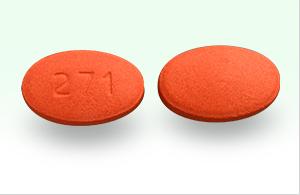Etodolac Dosage
Medically reviewed by Drugs.com. Last updated on Oct 24, 2024.
Applies to the following strengths: 200 mg; 300 mg; 400 mg; 500 mg; 600 mg
Usual Adult Dose for:
Usual Pediatric Dose for:
Additional dosage information:
Usual Adult Dose for Osteoarthritis
Immediate Release:
- Starting dose: 300 mg orally 2 to 3 times a day OR 400 to 500 mg orally twice a day
- For long-term use: 600 mg/day may be sufficient
- Maximum dose: 1000 mg/day
Extended Release:
- Starting dose: 400 to 1000 mg orally once a day
Comments:
- In chronic conditions, a therapeutic response is sometimes seen within 1 week of therapy, but most often is observed by 2 weeks.
- Immediate Release:
- Doses greater than 1000 mg/day have not been adequately studied.
- After achieving a satisfactory response, the patient's dose should be reviewed and adjusted as needed.
- Extended Release: The lowest effective dose should be used.
Uses:
- Immediate release: For acute and long-term use in the management of signs/symptoms of osteoarthritis and rheumatoid arthritis
- Extended release: For relief of the signs/symptoms of osteoarthritis and rheumatoid arthritis
Usual Adult Dose for Rheumatoid Arthritis
Immediate Release:
- Starting dose: 300 mg orally 2 to 3 times a day OR 400 to 500 mg orally twice a day
- For long-term use: 600 mg/day may be sufficient
- Maximum dose: 1000 mg/day
Extended Release:
- Starting dose: 400 to 1000 mg orally once a day
Comments:
- In chronic conditions, a therapeutic response is sometimes seen within 1 week of therapy, but most often is observed by 2 weeks.
- Immediate Release:
- Doses greater than 1000 mg/day have not been adequately studied.
- After achieving a satisfactory response, the patient's dose should be reviewed and adjusted as needed.
- Extended Release: The lowest effective dose should be used.
Uses:
- Immediate release: For acute and long-term use in the management of signs/symptoms of osteoarthritis and rheumatoid arthritis
- Extended release: For relief of the signs/symptoms of osteoarthritis and rheumatoid arthritis
Usual Adult Dose for Pain
Immediate Release: 200 to 400 mg orally every 6 to 8 hours
Maximum dose: 1000 mg/day
Comments:
- Doses greater than 1000 mg/day have not been adequately studied.
Use: For the management of acute pain
Usual Pediatric Dose for Juvenile Rheumatoid Arthritis
Extended Release:
6 to 16 years:
- Weight 20 to 30 kg: 400 mg orally once a day
- Weight 31 to 45 kg: 600 mg orally once a day
- Weight 46 to 60 kg: 800 mg orally once a day
- Weight greater than 60 kg: 1000 mg orally once a day
Use: For relief of signs/symptoms of rheumatoid arthritis
Renal Dose Adjustments
Mild to Moderate Renal Dysfunction: No adjustment recommended; caution recommended.
Severe Renal Dysfunction:
- Immediate release: No adjustment recommended; caution recommended.
- Extended release: Data not available
Advanced Renal Disease: Not recommended; if therapy must be started, close monitoring of renal function is recommended.
Comments:
- The pharmacokinetics of this drug after administration of the extended-release formulation have not been studied in subjects with renal dysfunction.
- This drug should be used with caution in patients with mild to moderate renal dysfunction; this drug may further decrease renal function in some patients.
Liver Dose Adjustments
Acute and chronic liver diseases: No adjustment recommended
If clinical signs/symptoms consistent with liver disease develop, systemic manifestations (e.g., eosinophilia, rash) occur, or abnormal liver tests persist/worsen during therapy: This drug should be discontinued.
Comments:
- The pharmacokinetics of this drug after administration of the extended-release formulation have not been studied in subjects with liver dysfunction.
- Clearance of this drug is dependent on liver function and could be reduced in patients with severe liver failure.
Dose Adjustments
Older adult patients (65 years and older):
- No dosage adjustment is generally needed based on pharmacokinetics.
- These patients may be more sensitive to antiprostaglandin effects than younger patients.
- Dosage adjustment of the extended-release formulation may be needed.
- Caution is recommended when treating these patients.
- Also when increasing the dose of the immediate-release formulation
Patients with recent myocardial infarction: Avoid use unless the benefits are expected to outweigh the risk of recurrent cardiovascular thrombotic events.
Patients with severe heart failure: Avoid use unless the benefits are expected to outweigh the risk of worsening heart failure.
Precautions
US BOXED WARNINGS:
- CARDIOVASCULAR THROMBOTIC EVENTS: NSAIDs cause an increased risk of serious cardiovascular thrombotic events (including myocardial infarction and stroke), which can be fatal; this risk may occur early in therapy and may increase with duration of use. This drug is contraindicated in the setting of coronary artery bypass graft (CABG) surgery.
- GASTROINTESTINAL (GI) RISK: NSAIDs cause an increased risk of serious GI side effects (including bleeding, ulceration, and perforation of stomach or intestines), which can be fatal; such events can occur at any time during use and without warning symptoms. Older adult patients are at greater risk for serious GI events.
CONTRAINDICATIONS:
- Hypersensitivity to the active component or any of the ingredients
- History of asthma, urticaria, or allergic-type reactions after taking aspirin or other NSAIDs
- In the setting of CABG surgery
Immediate release: Safety and efficacy have not been established in patients younger than 18 years.
Extended release: Safety and efficacy have not been established in patients younger than 6 years.
Consult WARNINGS section for additional precautions.
Dialysis
Hemodialysis:
- Immediate release: No adjustment recommended
- Extended release: Data not available
Comments:
- Hemodialysis does not significantly remove this drug from the blood.
Other Comments
Administration advice:
- Carefully consider potential benefits and risks of this drug and other treatment options before deciding to use this drug.
- Use the lowest effective dose for the shortest duration consistent with individual patient treatment goals.
- After the response to initial therapy has been observed, adjust the dose and frequency as appropriate per the individual patient's needs.
Storage requirements:
- Store at 20C to 25C (68F to 77F)
- Immediate release:
- Capsules: Protect from moisture.
- Tablets: Store in original container until ready to use; dispense in light-resistant container.
- Extended release: Protect from excessive heat and humidity.
Monitoring:
- Cardiovascular: Blood pressure (during initiation and throughout therapy); for signs of cardiac ischemia in patients with recent myocardial infarction; for signs of worsening heart failure in patients with severe heart failure
- Gastrointestinal: For signs/symptoms of GI bleeding
- General: Chemistry profile in patients on long-term therapy (periodically)
- Hematologic: CBC in patients on long-term therapy (periodically)
- Renal: Renal function in older adult patients
Patient advice:
- Read the US FDA-approved patient labeling (Medication Guide).
- Be alert for symptoms of cardiovascular thrombotic events (including chest pain, shortness of breath, slurring of speech); report any of these symptoms to your health care provider immediately.
- Be alert for signs/symptoms of GI ulcerations and bleeding; seek medical advice if any indicative signs/symptoms (including epigastric pain, dyspepsia, melena, hematemesis) are observed. This follow-up is important.
- Discontinue this drug immediately if any type of rash or fever develops; contact your health care provider as soon as possible.
- Be alert for symptoms of congestive heart failure (including shortness of breath, unexplained weight gain, edema); contact your health care provider if such symptoms occur.
- Discontinue therapy and seek immediate medical therapy if signs/symptoms of hepatotoxicity (e.g., nausea, fatigue, lethargy, pruritus, jaundice, right upper quadrant tenderness, influenza-like symptoms) occur.
- Seek immediate emergency help if signs of an anaphylactic reaction (e.g., difficulty breathing, swelling of face/throat) occur.
- Discontinue this drug at the first appearance of skin rash or any other sign of hypersensitivity.
- If pregnant, avoid use of this and other NSAIDs starting at 30 weeks gestation.
More about etodolac
- Check interactions
- Compare alternatives
- Pricing & coupons
- Reviews (82)
- Drug images
- Latest FDA alerts (4)
- Side effects
- Patient tips
- During pregnancy
- Drug class: Nonsteroidal anti-inflammatory drugs
- Breastfeeding
- En español
Patient resources
Other brands
Professional resources
Other brands
Related treatment guides
See also:
Further information
Always consult your healthcare provider to ensure the information displayed on this page applies to your personal circumstances.


